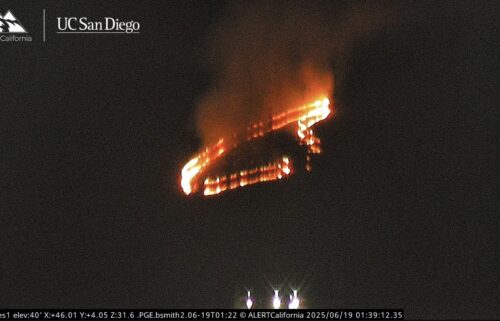‘Magic mirror’: Hidden image revealed in reflection of centuries-old artifact
Oscar Holland, CNN
Amid the thousands of treasures in the Cincinnati Art Museum’s East Asian art collection, a small bronze mirror dating back to the 15th or 16th century always seemed rather unremarkable.
Last exhibited in 2017, it had spent much of the preceding decades in storage, where it sat on a backroom shelf alongside other objects excluded from public display.
But the artifact had a secret hiding in plain sight.
While researching so-called “magic mirrors” — rare ancient mirrors that, in certain light, reveal images or patterns hidden on their reflective surfaces — the museum’s curator of East Asian art, Hou-mei Sung, saw something resembling the examples from Edo-period Japan.
The item in storage in Cincinnati, Ohio, was smaller than the ones held in museums in Tokyo, Shanghai and New York City. It also featured a more complex style of Chinese script. Yet, Sung recalled there was something “very similar” about it.
So, last spring, she visited the museum’s storage rooms accompanied by a conservation expert.
“I asked her to shine a strong, focused light on the mirror,” Sung said on a video call from Cincinnati. “So, she used her cell phone (flashlight) and it worked.”
On the wall before them was the appearance of texture in the reflected light — not a distinct image, but enough to warrant further investigation. Following experiments using more powerful and focused lights, the mirror eventually revealed the image of a Buddha, rays of light emanating from his seated form. The inscription on the mirror’s back spells out who was depicted: Amitabha, an important figure in various schools of East Asian Buddhism.
The discovery makes the museum one of only a handful of institutions in the world to own a magic mirror, according to Sung. The curator is only aware of three others in possession of rare Buddhist-themed ones, including the Metropolitan Museum of Art in New York.
“We were so excited,” Sung said.
Ongoing mystery
Before the invention of today’s glass mirrors, people from cultures around the world gazed into polished bronze, from ancient Egypt to the Indus Valley. The ancient art of Chinese magic mirrors was first developed during the Han dynasty, around 2,000 years ago, though they were also later made in Japan.
To create the mysterious effect, artisans began by casting images, words or patterns onto one side of a bronze plate. Scientists believe they then scratched and scraped the plain surface on the other side, before polishing it until it became reflective like a conventional mirror. Because the plate was of varying thickness, due to the embossed design, the process created very slight changes in curvature on the seemingly blank mirrored side. A mercury-based substance was then used to make additional surface stresses that were invisible to the naked eye but matched the elaborate patterns on the back, according to an article in the UNESCO Courier journal.
When sunlight hits the reflective surface in a certain way, a hidden image — matching the design on the back — would be revealed, giving the illusion that light was passing right through the mirror. For this reason, they are known in Chinese as “transparent” or “light-penetration” mirrors. (In the case of the Cincinnati Art Museum’s discovery, however, a second metal plate was likely soldered onto the back, leaving the original embossed Buddha concealed inside.)
The mirrors baffled Western scientists who encountered them in the 19th century. And while their optics are now broadly understood, Sung said experts still don’t know precisely how craftspeople worked the metal.
“No matter how much you can explain theoretically, it all depends on the master who polishes the surface which is tremendously difficult,” she said. “That’s why they are so rare.”
Measuring about 8.5 inches in diameter, the museum’s mirror was likely used as a religious ornament and may have hung in a temple or noble household. The museum is yet to decipher whether it originated in China or Japan, though Sung believes it is most likely the former.
The item was first recorded in the museum’s Asian art collection in 1961, though the curator thinks it may have been acquired long before then. She also suspects that other institutions and collectors are in possession of magic mirrors without realizing.
“I found a lot in online auctions that have a similar design to ours, but (the auction listings) never say they’re magic mirrors,” she said, adding: “I believe there could be some mirrors out there that people don’t even know are magic.”
The mirror will be on display at the Cincinnati Art Museum from July 23.
The-CNN-Wire
™ & © 2022 Cable News Network, Inc., a WarnerMedia Company. All rights reserved.

